I2AO Part 8b: Moons of the Solar System
Back to the Index of I2AO (Introduction to Astronomy Online)
PART 8b: MOONS OF THE SOLAR SYSTEM by Ian Kemp
This page details some of the more interesting moons of the Solar System. The ASNSW is grateful for the information and images contributed on this page by Dr Ian Kemp, astrophysicist at ICRAR (International Centre for Radio Astronomy Research) in Western Australia. This content was first posted to the ASNSW Facebook Group during 2020 as day-by-day "Moons of the Solar System" features. Here, they are organised by position in the Solar System, working outwards from the Sun.
- Moons of Earth - the Moon, 2020CD3, 2010TK7
- Moons of Mars - Phobos, Deimos
- Moons in the Main Asteroid Belt - Dactyl
- Moons of Jupiter - Io, Europa, Ganymede, Callisto, Patroclus and Menoetius
- Moons of Saturn - Mimas, Enceladus, Tethys, Dione, Rhea, Titan, Hyperion, Iapetus, Phoebe, Epimetheus & Janus, Pan, Atlas, Propeller moons
- Moons of Uranus - Titania, Ariel, Umbriel, Miranda
- Moons of Neptune - Triton
- Moons of Pluto - Charon
- Moons in the Kuiper Belt - Dysnomia, G!ò'é !Hú
- Epilogue
1.1 The Moon
It's the Moon (as in, Earth's Moon, Selene, Luna etc)! But the image below from NASA's LRO shows the far side and the South Pole. If there is water on the Moon, it's most likely to exist in the permanently shadowed craters at the poles. Several missions to detect water - including radar and the crashing of objects into the craters to remotely measure 'ejecta' from Earth - have been frustratingly inconclusive. H has been detected, OH has been detected, but not H2O. However, there are definitely hydrated minerals in Moon rocks brought back by the Apollo missions. Was this 'bound' water in the Moon when it was created? Or was it carried there by comets and asteroids, and somehow bound into the rocks? There are still a lot of mysteries about lunar geology and the Apollo rocks are still being actively studied as new instruments and techniques are developed.
Figure 1.1: The Moon (below)
Image Credit: NASA
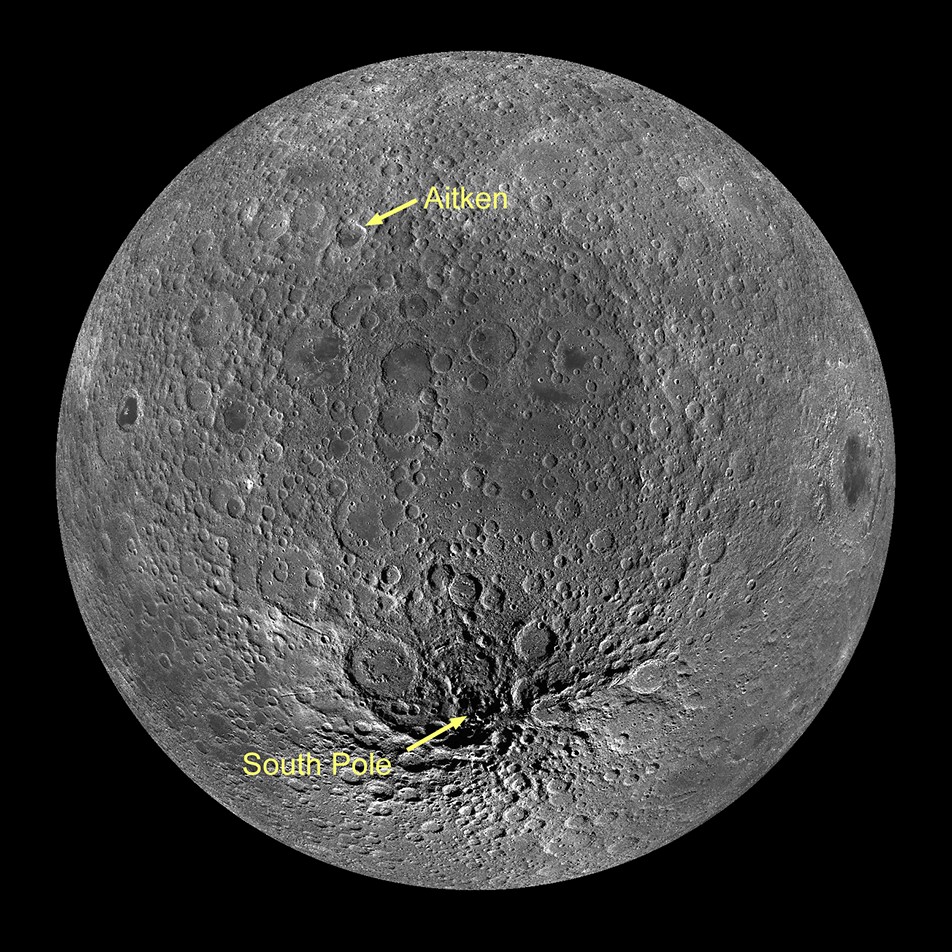
1.2 2020CD3
Gone but not forgotten, 2020CD3, Earth’s third moon. Say what?! Yes, Earth has, or more accurately, recently had three moons. This one was discovered orbiting the Earth in February 2020. Calculations showed it had been here for about three years, but now it’s gone - some time in March 2020, the combined gravitational pulls of the Earth, Sun, Moon, Venus and Jupiter got just right to pull it away from Earth’s influence and into Solar orbit and, presumably, back into solar orbit where it came from. Photo (a) below shows a colour image of our erstwhile companion, shot using the 8m Gemini telescope in Hawaii. The 3-colour stripes are images of stars, smeared out as the telescope tracked the moon. It was definitely a tiddler, estimated at somewhere between two and four metres across. It never had the chance to settle into a stable orbit. Instead, it moved around chaotically, at one point coming about 13,000 km from Earth - about half way between us and the geostationary satellites we rely on for phone, internet, TV, etc. Photo (b) below shows the calculated orbit of 2020CD3 during the three years it played with us. The moral of this story: all moons are temporary.
Figure 1.2.a. Earth's mini-moon, 2020CD3, is the little dot in the centre of the image below.
Image Credit: The international Gemini Observatory/NSF’s National Optical-Infrared Astronomy Research Laboratory/AURA 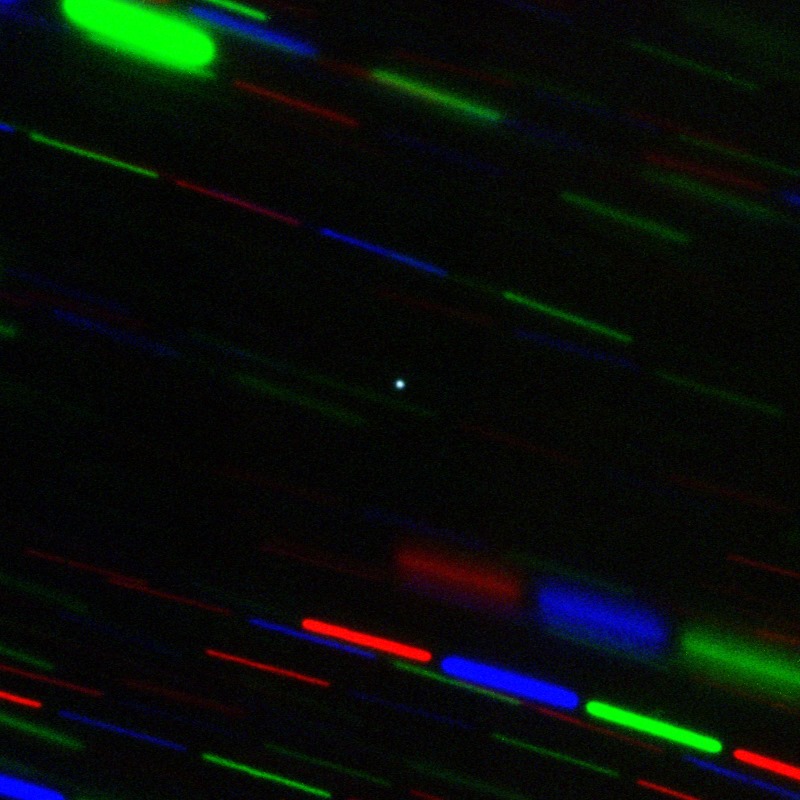
Figure 1.2.b. Orbit of 2020CD3
Image Credit:Created with the orbit simulator written by Tony Dunn
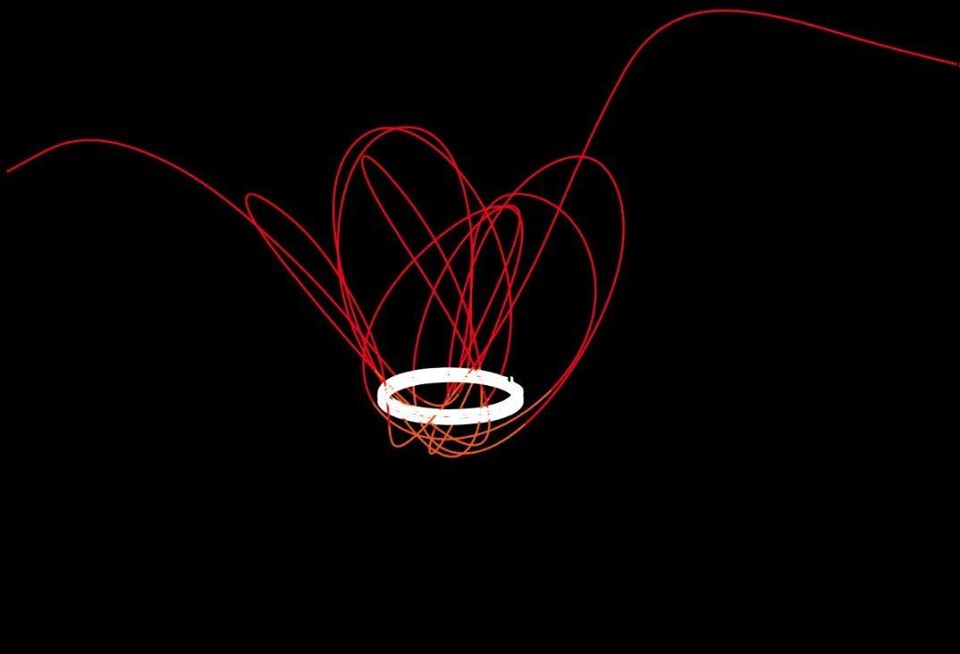
1.3 2010TK7
It’s Earth’s second moon, 2010TK7. Please indulge me, I have a lot of love for this small chunk of rock. First, I’m cheating a bit because I’m stretching the definition of “moon”. Usually the term describes something that orbits a planet, dwarf planet or asteroid etc. 2010TK7 is a 'Trojan’, sometimes called a Trojan Asteroid and sometimes called a Trojan Moon. In one sense it orbits the Sun which is why it’s called an asteroid, but if you plot its orbit in a rotating frame of reference (in which the Earth is stationary) you will find that it orbits the L4 Lagrange point - a spot out in space where its position forms an equilateral triangle with the Sun and Earth. Note this is not a constant because Earth's orbit is actually elliptical. But 2010TK7 pretty much shares Earth’s orbit round the Sun and wobbles around a point 1/6 the way around the orbit, ahead of Earth.
2010TK7 is about 300 m in diameter, so very small compared to our main moon, the Moon. It was originally spotted by the IRAS satellite in 2010. Its orbit is unstable - if it was only involved with the Sun and Earth, it could wobble around in a stable 'tadpole’ orbit pretty much forever, but its path is disrupted by the attraction of Venus as it overtakes us in its orbit, and by Jupiter as we overtake it. The other major planets add their nudges from time to time, so the 'tadpole’ path is chaotic and eventually a conjunction of forces will happen just at the right moment to throw 2010TK7 away from the Lagrange point and it will become just another satellite of the Sun. According to my own research, the longevity of this type of object could be anywhere from zero to 10 million years.
Figure 1.3: Image of 2010TK7 below: A Glimmer in the Eye of WISE, Asteroid 2010 TK7 is circled in green, in this single frame taken by NASA's Wide-field Infrared Survey Explorer, or WISE. The majority of the other dots are stars or galaxies far beyond our Solar System. Astronomers discovered this object - the first known Earth Trojan asteroid - after sifting through asteroid candidates identified by WISE. This image was taken in infrared light at a wavelength of 4.6 microns in Oct. 2010. The original NASA image has been modified by cropping.
Image credit: NASA/Jet Propulsion Lab-Caltech/UCLA

2.1 Phobos
Be afraid! Phobos (meaning "fear") is the largest moon of Mars. 'Largest' is a comparative concept, it is only 25 km across and probably a captured asteroid. It has the lowest orbit of any moon in the Solar System. At just under 6000 km above the surface, it orbits Mars three times a day. The orbit is unstable due to tidal forces (differential pull on the two sides of the tiny object) dissipating its orbital energy, and it is spiralling in towards a collision with Mars - maybe after it is ripped open by the tidal differential. It is tidally locked, always presenting the same face to Mars - and it's the leading side that has this comparatively massive crater. It also has chains of craters from boulders bouncing along after impact. This photo is from the 1978 Viking 1 mission.
Because it orbits faster that Mars spins, if you were standing on Mars, you'd see it rise in the West and set in the East!
Figure 2.1.a: The below photo of Phobos is from the 1978 Viking 1 mission.
Image Credit: NASA
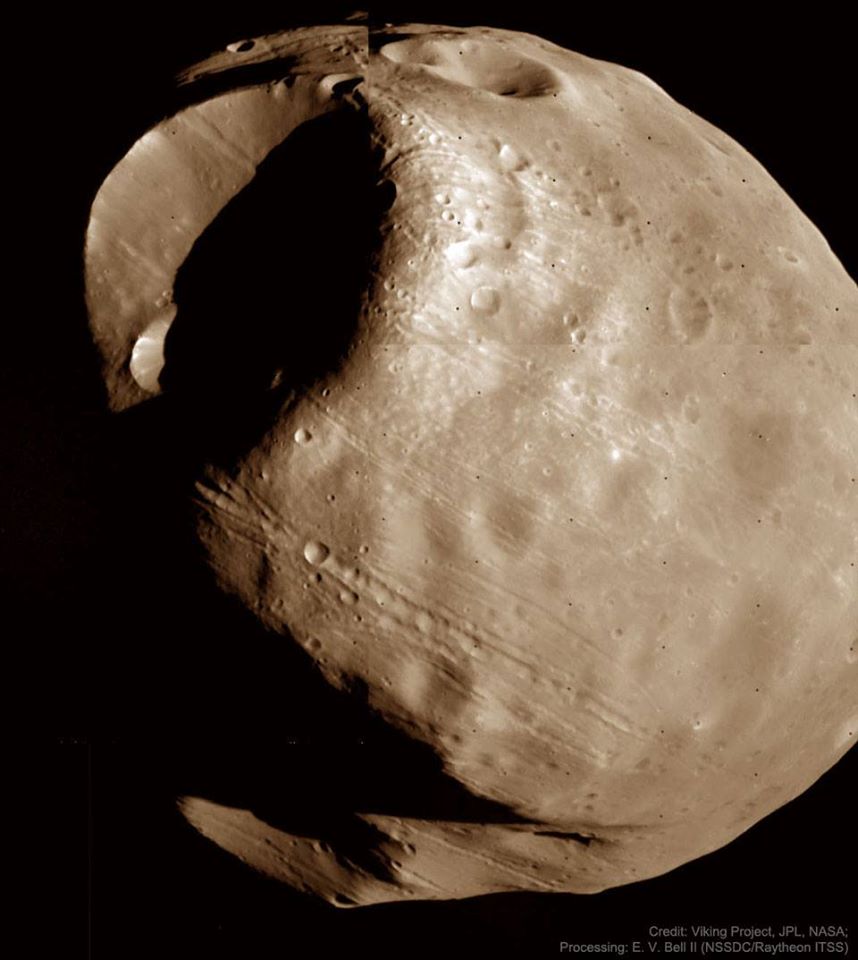
Figure 2.1.b. Below is Phobos as seen from the Mars Global Surveyor, showing the inside of Stickney Crater.
Image Credit:NASA
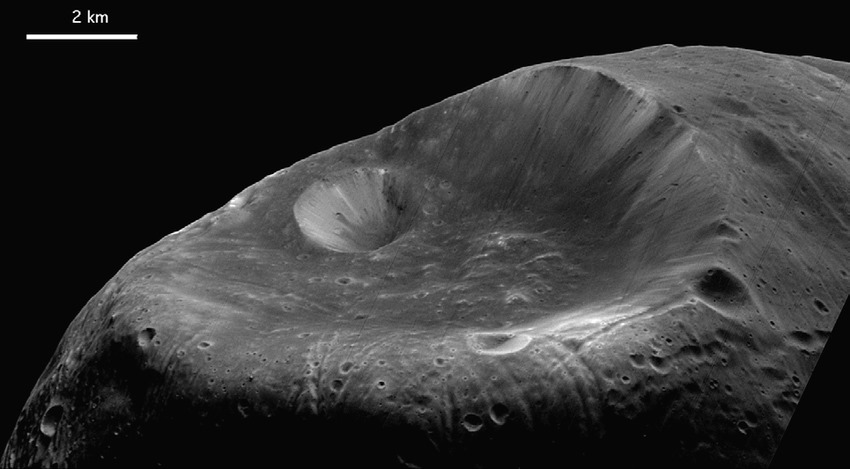
2.2 Deimos
Be afraid, be very afraid: it’s Deimos, the second moon of Mars. Its name means "terror". It has a lot of similarities to its larger sibling, Phobos, but it’s only about half the diameter of Phobos (it’s about 15 km across at the widest point), and 1/6 the mass. Like phobos, it is a battered piece of rock, not massive enough to pull itself into a spherical shape. It orbits faster than Mars rotates so, like Phobos, it rises in the West and sets in the East! It also seems to be made of similar material to Phobos, suggesting that both of them were captured from the Main Asteroid Belt, although this is not certain as Deimos has a nearly circular orbit, which is not what you’d normally find in a capture unless it’s had a long time and some kind of braking mechanism to reduce the elliptical orbit that normally results from capture.
You might remember that Phobos is destined to crash into Mars at some point - well Deimos is heading the other way and on it’s current path it should increase in altitude and eventually escape Mars, back into Solar orbit. From the photo below, you can see that it has picked up quite a lot of dust - which has softened the sharp edges of craters and filled in some smaller craters completely, leaving a surface which is quite smooth, say, compared with Earth’s Moon. The dust makes the surface dark - it only reflects about 7% of light falling on its surface - about half that of Earth’s Moon, and totally unlike Enceladus with its 81% reflectivity.
The Japanese Aerospace Exploration Agency is working on a Mission to visit both Phobos and Deimos, and return samples of Phobos to the Earth, tentatively launching in 2024 and returning around 2029. Can’t wait! The photo below shows two images of Deimos, from the Mars Reconnaissance Orbiter in 2009.
Figure 2.2 Deimos
Image Credit: NASA, Mars Reconnaissance Orbiter (MRO), 2009

3. Moons in the Main Asteroid Belt
3.1 Dactyl
The Galileo spacecraft passed through the asteroid belt between Mars and Jupiter in 1994, on its way to Jupiter. It visited a couple of asteroids, and it was only later that someone noticed that the images of the asteroid 243 Ida included a tiny moon, now called Dactyl. For obvious reasons, little is known about Dactyl, except that it's about 1.5 km across and has a lot of craters. We suppose it's made of similar material to Ida (mostly Silicate rock). It shows that gravity can lead to the capture of moons by Planets, Dwarf Planets, Lagrange Points and Asteroids. The photos below (from Galileo) show Ida with Dactyl, and a high-resolution picture of Dactyl.
Figure 3.1.a. Ida and Dactyl
Image Credit: NASA
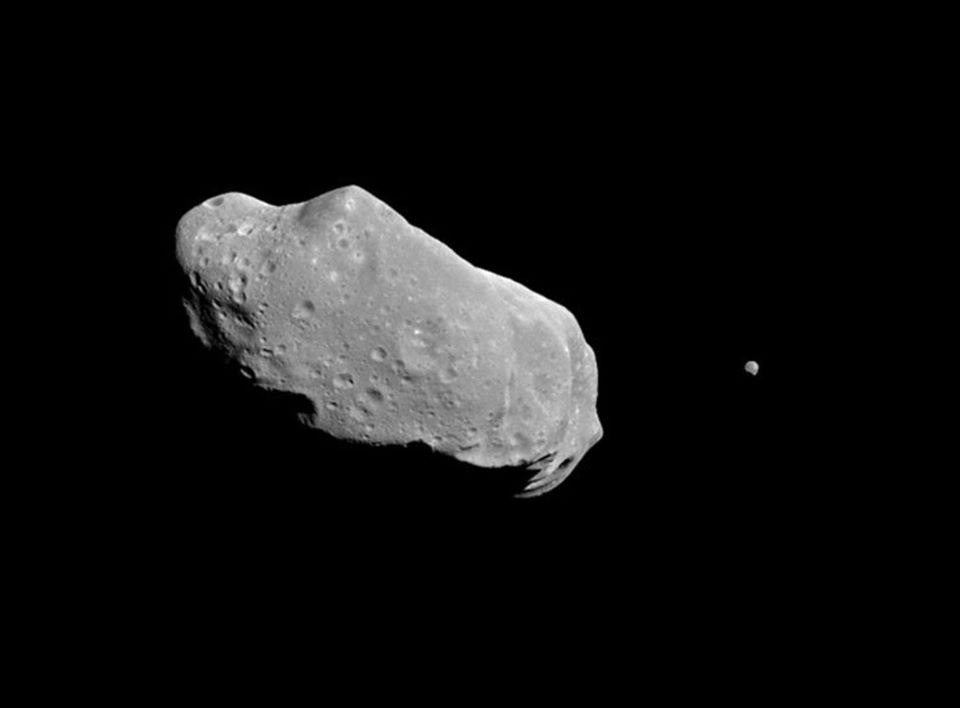
Figure 3.1.b. Dactyl
Image Credit: NASA
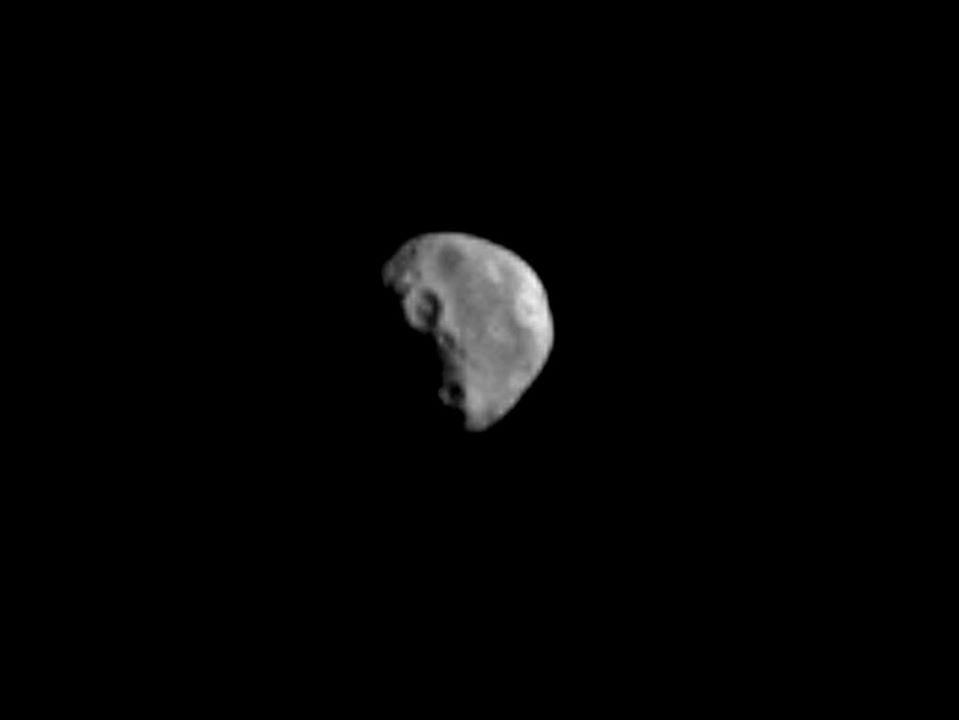
4.1 Io
I don’t really have a favourite moon but, if I did, it would be Io. Io is the third-largest moon of Jupiter. It is one of the four that can easily be seen from Earth using binoculars or even a cheap telescope, and out of the four, it orbits the closest to Jupiter. It is also probably the most tectonically active body in the Solar System. Its closeness to Jupiter means there is significant discrepancy in the gravitational pull of its giant parent, between the near side and the far side - a tidal pull. Because its orbit is elliptical, Io moves in and out as it travels around Jupiter every 42 hours, and the tidal discrepancy grows and falls accordingly. This change in the tidal pull causes the entire moon to flex by over 100 metres and provides the energy for its amazing geological activity. Io has grown mountain ranges over 6 km high due to tectonic movement (something similar to how mountains form on Earth) and is covered with over 400 active volcanoes, which spew subsurface liquid onto the surface. It has an iron core (like Earth), partly molten (like Earth), a rocky silicate mantle, and a coating of sulphur and sulphur compounds on the surface. The volcanoes spew silicate magma (molten rock) and sulphur in plumes which can reach 300 km above the surface (for comparison, the International Space Station orbits about 400 km above the Earth).
If the volcanic and sulphur-encrusted surface doesn’t make it hellish enough, Io orbits in the middle of a high intensity band of radiation sustained by Jupiter’s magnetic field. Finally, it is worth noting that, while material ejected from the volcanoes can be at 1600 degrees C, the normal surface temperature is around -130 degrees C. The atmosphere of sulphur dioxide freezes and settles on the surface each day while Io is in the shadow of Jupiter, then fluffs back up into an atmosphere again when it comes back into Sunlight. A fascinating place, but you wouldn’t want to go there for a holiday. The two photos from data collected by Galileo in 1997 show (a) the face of Io (b) a volcanic plume arcing out into space.
Figure 4.1.a. The face of Io (below)
Image Credit: NASA
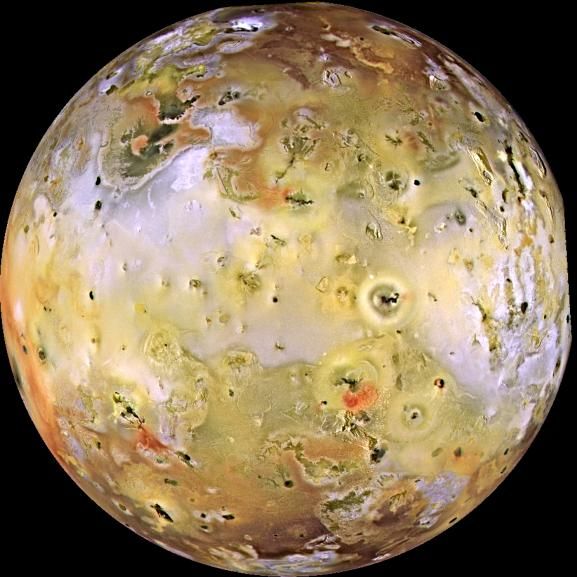
Figure 4.1.b. A volcanic plume visible on the limb of Io (upper left in the image below).
Image Credit:Source
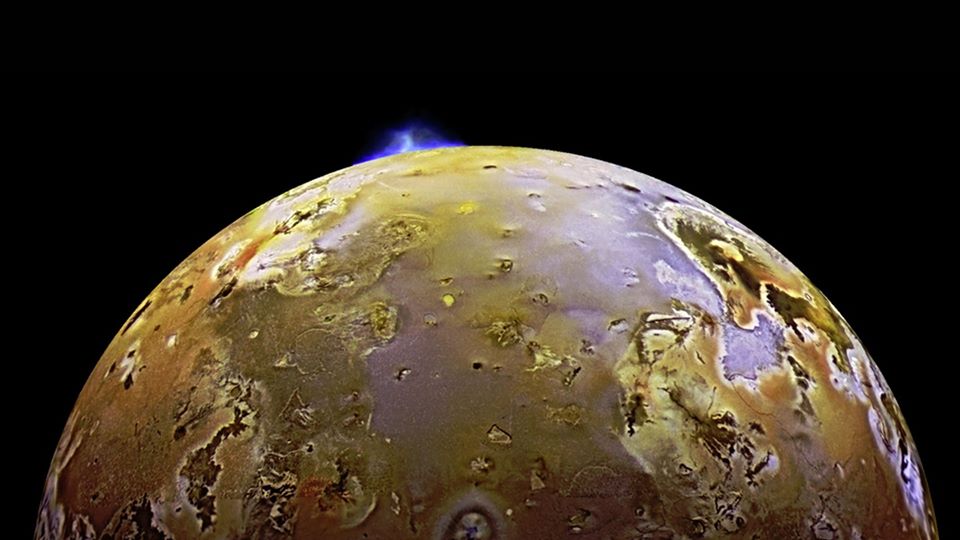
4.2 Europa
Europa is the 4th largest moon of Jupiter. At 1500 km diameter, it is slightly smaller than Earth’s Moon. It has an icy surface covered in fracture lines, but with a distinct lack of craters, implying that the surface is dynamic and can reform after an impact. At the smaller scale, it has ‘chaotic’ regions which clearly look like broken and re-frozen ‘rafts’ of ice (second photo below). These features are most consistent with an ocean of liquid water underneath frozen ice floes on the surface. Measurements by Galileo also indicate the presence of sodium chloride and sulphates, the most likely source of sodium chloride being rock or maybe even hydrothermal vents under the ocean. The presence of these components makes Europa a potential location for water-based life to arise, which is exciting to some people and, as a result, Europa has starred in its own SF movie and multiple books, and been lectured about at length. NASA is planning a serious exploration of Europa, with two planned missions: the Europa Clipper, planned to do remote sensing from multiple flybys launching in 2024; and the Europa Lander planned to, well, land, launching in 2025. Also, ESA is planning the JUICE mission which will visit Europa and other moons, planned for launch in 2022 for arrival in 2029. One of the problems for the explorers is that Europa lies within an intense radiation belt of Jupiter, which is expected to fry a normal spacecraft within a month or two. This is the main reason why ‘Europa Clipper’ is being designed to do flybys rather than orbit Europa - so that it will last long enough to return its data to Earth. Whether the intense radiation is a good thing or a bad thing from the point of view of astrobiology enthusiasts remains to be seen. Either way, expect to hear a lot more about Europa within the coming 10 years.
Figure 4.2.a. Europa as seen by the Galileo spacecraft (below)
Image Credit: NASA

Figure 4.2.b. Broken and re-frozen ice floes / rafts on Europa. The photo below shows an area 42 x 34 km.
Image Credit: NASA

4.3 Ganymede
The largest moon of Jupiter and the largest in the Solar System is here imaged by the Galileo spacecraft. It is larger than the planet Mercury, but has less mass because it is about 50% ice and 50% rock. Crater counting shows that the dark patches are the older terrain on Ganymede, while the lighter parts are newer. This is a reversal of what we see on the Earth's moon, in which the darker volcanic basalts are younger features.
Figure 4.3. Ganymede (below) Image Credit: NASA

4.4 Callisto
Callisto, the second largest moon of Jupiter, at 4800 km diameter, was once described as “the most boring object in the Solar System". It’s just a bit smaller than the planet Mercury but, like Ganymede, it has a lower mass than Mercury because it’s about 60% rock and 40% ice. Callisto is notable for its cratering. It has possibly the heaviest-cratered surface in the Solar System showing that the surface is very old and, like Rhea, it doesn’t have any processes to refresh the surface (such as plate tectonics, or melting/refreezing like we have seen on some other moons). It also doesn’t seem to have any large-scale structure (like the mare on the Moon, the patches on Ganymede, etc.). Like Europa, it potentially has liquid water under the surface but, unlike Europa, it isn’t bathed in high intensity radiation, because it orbits so much further out from Jupiter. We will find out more about it when ESA’s JUICE probe arrives some time after 2029.
Even at its distance of 1.9 million km (about 4x the distance between the Moon and Earth), it fairly whips around its orbit - its day (and its orbital period) is 16.7 Earth days. Because Jupiter's major moons move so fast, they are always interesting to look at from your back yard with binoculars or just a small telescope - they change position from day to day.
Figure 4.4. The colour image below was made using data from the Galileo spacecraft in 2001.
Image Credit: NASA

4.5 Patroclus and Menoetius
Can moons have moons? Well, yes, but they are not stable, so they won’t last long. If something orbits a moon, it’s inevitable that it will be perturbed by the gravitational field of the primary and, sooner or later, it will get a push as it’s heading in just the right direction ... and either be bumped out of lunar orbit or be sent crashing in to its moon. So, they can exist, but they should be short lived which is why we don’t see any. What’s that Skippy? You’ve seen one?! Well yes, but only if you indulge me and let me stretch the definition of ‘moon’ to include something that orbits a Lagrange Point (remember 2010 TK7?).
If so, here is a positive example: 617 Patroclus, a Trojan Moon of Jupiter, and it’s Moonmoon Menoetius. The primary is about 140 km in diameter so, for example, it’s way bigger than either of Mars’ moons. The moonmoon is only slightly smaller, so it could perhaps be called a binary planet?!? As I discussed when talking about 2010 TK7, in one sense the system orbits the Sun - but hang on, all moons orbit the Sun - after all, Earth’s Moon goes around the Sun too as it wobbles around the position of Earth. In another sense, the system orbits Jupiter’s L5 Lagrange point, which is the point that forms an equilateral triangle with the Sun and Jupiter, but trailing along behind Jupiter. It’s thought to be a ‘primordial pair’, i.e. they were formed together when dust coalesced, rather than hooking up later (it’s quite difficult for objects of near equal mass to fall into stable orbit together).
617 Patroclus and Menoetius are on NASA’s list for a visit, from a robot space probe called “Lucy” which is intended to visit some asteroids in the Main Belt and some Jupiter Trojans. It’s intended for launch in late 2021, and a flyby of this pair in 2033. Fun fact - did you know it’s estimated that there are more Trojan Asteroids / Trojan Moons of Jupiter, than there are asteroids in the Asteroid Belt?
Figure 4.5. Patroclus and Menoetius (below) are binary Trojan Asteroids of Jupiter
Image Credit: Hubble Space Telescope and STScI
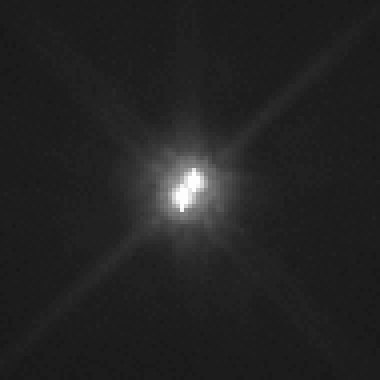
5.1 Mimas: The image of Mimas, below, was taken by the Cassini probe. This moon, like most in the outer Solar System has a large amount of ice. In fact, this one is mostly ice, with just a small amount of rock. Its mass is barely enough to hold it in a spherical shape, so it was lucky to survive the impact that created this 130 km diameter crater named Herschel (after the discoverer of Mimas). The crater is around 5 km deep, which is huge considering the moon itself is about 400 km in diameter. If you could drive around the equator, the entire trip would be less than Perth to Adelaide. No doubt photo-decomposition of ice occurs here as it does on Ganymede, but the body is much smaller and doesn't have enough gravity to maintain an atmosphere.
Image 5.1. Mimas (below)
Image Credit: NASA
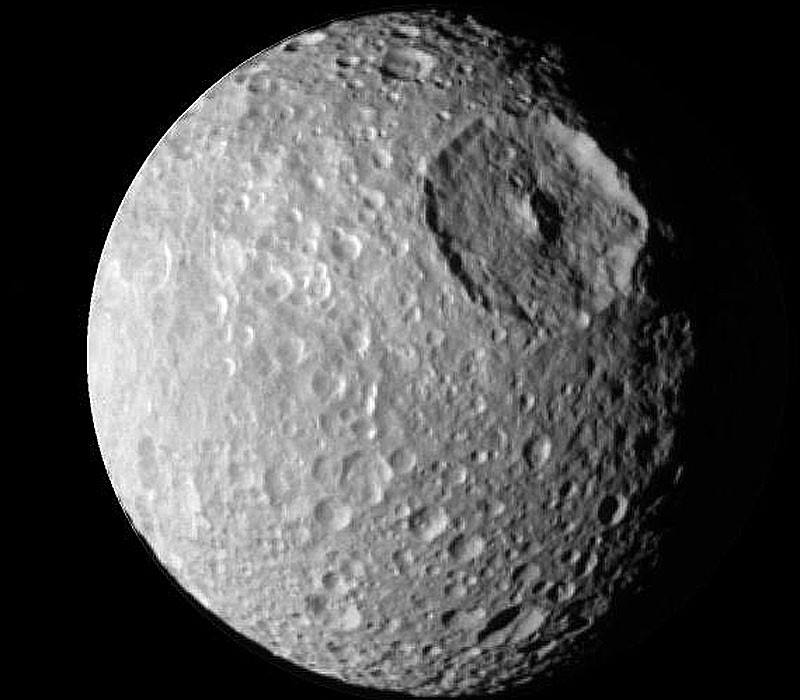
5.2 Enceladus
Enceladus is the 6th-largest moon of Saturn. Enceladus is small, relatively speaking, at only 500 km across, but it has the distinction of being the most reflective body in the Solar System, with an albedo of 0.81 (it reflects 81% of the light falling on it). The visit by the Cassini spacecraft in 2005 showed that it has a fresh (therefore active) icy surface with lots of interesting features. Ongoing analysis of the data from Cassini has revealed a lot about this interesting moon. Data have shown that, like Jupiter’s moon Europa, Enceladus has a global salt-water ocean beneath its icy surface. It is actively ejecting water out though geysers breaking through the ice, and some of the water it’s flinging out becomes ice particles in the rings of Saturn. In addition to the geysers, the best evidence for the subsurface ocean has actually come from very careful measurements of the moon’s orbit and rotation which don’t quite fit calculations made assuming it’s a solid body. The geysers also contain ammonia and methane, suggesting that the water is reacting with rock and organic compounds on the solid surface under the ocean. If you’re interested in prospects for water / carbon based life elsewhere in the Solar System, a trip to Enceladus should be on your list.
Figure 5.2.a. The surface of Enceladus (below)
Image Credit: NASA/Cassini

Figure 5.2.b. Geysers spew water from beneath the surface of Enceladus (below)
Image Credit: NASA/Cassini

5.3 Tethys
"Hang on, we've already seen that one! Oh no you haven't, that was Mimas, this one's Tethys, another moon of Saturn. At 1066 km diameter it's more than twice the size of Mimas, but it looks a bit similar because of the giant impact crater (actually a "multi-ringed impact basin") - which itself is around the size of Mimas! Tethys is the second moon of Saturn by mass, but the 5th-largest in size. Tethys is made mostly of water ice (though at its typical temperature of -187C, ice is as hard as rock) and has a relatively low crater count, suggesting that its surface solidified quite late. It also has a shiny icy surface which is thought to be dusted up a bit by water particles ejected from the geysers of Enceladus! At the top of this photo you can see the start of a giant canyon which extends almost from the North pole to the South pole - varying from about 3 km to 5 km deep. It may have been formed by the impact that made that big crater, or it could have formed separately when the frozen surface tried to accommodate a shrinkage or expansion of the moon. However, it doesn’t have a rocky interior (like Titania - refer 6.3), so we can’t use the explanation of radioactive re-heating.
One of the things I love about Tethys is that it has two Trojan moons all of its own! Telesto and Calypso share Tethys's orbit, wobbling around the L4 and L5 Lagrange points ahead of and behind Tethys. L4 and L5 are surprisingly stable. If you push a body away from the Lagrange point it will tend to fall back in. In the absence of drag or friction, it starts to oscillate. The presence of these two Trojans suggests that the orbit of Tethys has been stable for a long time, even though it seems to have a fresh surface. It also has a coating of some red material on its 'leading' face (like most long-serving moons it is tidally locked to Saturn).
Figure 5.3. Tethys (below)
Image Credit: NASA/Cassini

5.4 Dione
Dione, Enceladus’ big sister? At about 1120 km diameter, Dione is about twice the size of Enceladus. Gravimetric studies suggest it is about 70/30 water ice and rock, and it, too, may have a liquid water ocean under the frozen surface. Its surface has features I hope you recognise by now - a variety of craters and a number of long rift valleys which probably formed when the surface expanded at some point in its history. But Dione has a mystery ... it is tidally locked with Saturn, and it has a higher crater density on one side than on the other. Which side? Leading side? No! For some reason it has a higher crater density on the trailing side, which is a bit like finding raindrops preferentially hitting the back window of your car rather than the windscreen! The theory in this case is that some kind of impact or gravitational near miss has spun Dione around at some point, so what was its leading side is now at the back. If you have any better ideas please let me know. We haven’t seen evidence of water erupting from the surface of Dione, but it does have a thin oxygen atmosphere. This is probably formed from photo-decomposition of ice. By the way, Dione is another one of my pet moons because, like Tethys, it has its own two orbit-sharing Trojan Moons! These are called Helene and Polydeuces and they travel around in the L4 and L5 Lagrange points, 60 degrees ahead of and behind Dione. In addition, it has a special gravitational relationship with Enceladus and Mimas (whom we have already met). Their rotations are connected via ‘gravitational resonance’ - the interactions as they overtake in their orbits keep them locked in fixed mathematical ratios. The influence of Dione keeps Enceladus locked in an orbital period of half that of Dione. In turn, Enceladus has a 3:2 resonance with Mimas so, for the time being, these three moons are stabilised in their orbits. Computer modelling shows that in the long run, they will break out of this pattern and one or more of them will enter a chaotic orbit for a while until the whole system readjusts. It might take a large asteroid passing through to upset the applecart, but the point is that in the long run all moons are temporary.
Figure 5.4. Dione (below)
Image Credit: NASA/Cassini

5.5 Rhea
This moon of Saturn is about 1400 km in diameter. If you could drive around the equator, a round trip would be like driving from Perth to Sydney. It is heavily cratered, showing that it has an ancient surface, so there is no geological processing going on within Rhea.
Figure 5.5. Rhea's surface (below)
Image Credit: NASA
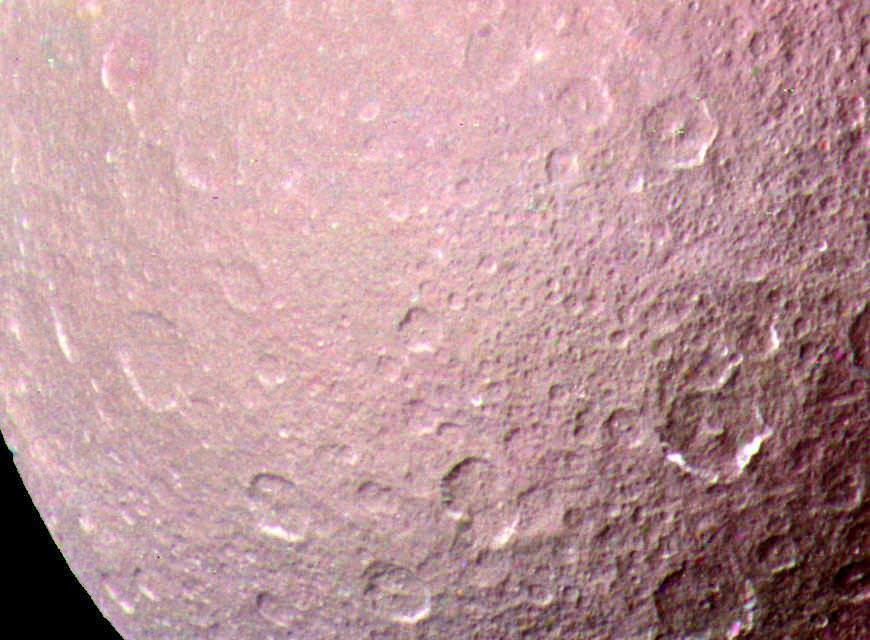
5.6 Titan
The $3 billion video. The video (link below) cost US$3 billion. Admittedly, that money got other data in addition to the video, but this is one of the most amazing bits of cinematography I’ve ever seen. The Cassini mission was a collaboration between two of Earth’s major space agencies: NASA and ESA. The spacecraft visited a few Solar System bodies on its way to its main target, Saturn, where it collected data on the moons and rings before ditching itself into Saturn. One of the highlights of the trip, in 2005, was the release of the sub-craft Huygens, built for ESA, which made a soft landing on Titan, the largest moon of Saturn.
Titan is the second-largest moon in the Solar System (Ganymede is the largest). It is larger than Earth’s moon and larger than the planet Mercury. It has a large proportion of ice, and a yellowish-coloured atmosphere, which hides the surface but can be penetrated by radar. It’s thought to have a rocky inner core and an outer ice core and, yes, it's yet another moon with a subsurface ocean of water - this time containing ammonia rather than salt. Titan has a complete atmosphere/fluid cycle: lakes of liquid on the surface partly evaporate, forming clouds, which can cause rain, which in turn forms rivers and replenishes the lakes. On Titan the fluid is not water, though, it’s hydrocarbons - mostly methane and ethane. The atmosphere is mostly nitrogen (like on Earth, only colder). The moon may also have cryovolcanoes squirting out liquid water from the reservoirs below the hydrocarbon surface. The surface itself shows evidence of large areas of hydrocarbon 'sand' (described as being like coffee grounds!) which has been formed up into sand dunes by winds in the atmosphere. Someone could write a whole book about Titan, and maybe they have. But for me, I recommend you look at the optical photo (from Cassini) and watch the $3 billion video. There are different versions but I have linked one with quite a good narration by David Harrington.
Figure 5.6.a. Titan's surface (below), as seen from the Huygens probe during descent
Image Credit: NASA/ESA Huygens

Watch the video: Descent and landing on an alien moon.
Figure 5.6.b. In the image below, Titan makes a transit and shadow transit of Saturn
Image Credit: Trevor Barry, Broken Hill Observatory
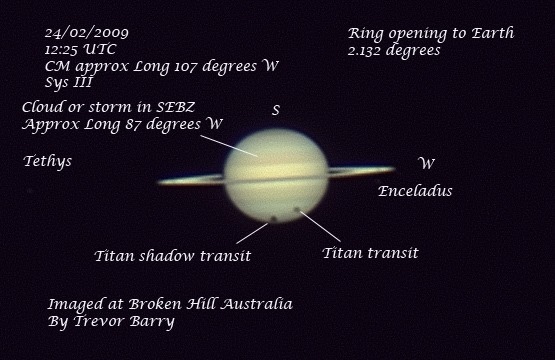
5.7 Hyperion
Hyperion is an irregular moon of Saturn. It’s irregular alright! It’s not massive enough to form into a spherical shape, so it has an irregular shape. It’s orbit, probably due to its interaction with Titan, is not a stable predictable orbit, but a chaotic mess. It is not tidally locked like most moons, but turns around in a random fashion - so its surface is relatively uniform, unlike some of the larger moons that have a coating on the leading or trailing side. Also, it has a large crater that allows us to see 'inside' and view its porous nature - being mostly ice with a small amount of rock, it appears to be more of a 'rubble pile' than a solid moon, with about 60% solid and 40% cavities. Hyperion is around 410 x 260 x 220 km, and may be a remnant of a larger object that was broken apart by an impact. It has been described as looking like a sponge or a wasp's nest. Because it’s a long way from Saturn (1.5 million km) there is not much of a gravitational gradient across it - so it experiences little heating even though its orbit has quite a high eccentricity (0.1). So, it lacks a source of heat that might soften out or refresh the surface.
Figure 5.7. Hyperion (below)
Image Credit: The photo is from our old friend Cassini, which encountered Hyperion in 2005 and 2011.
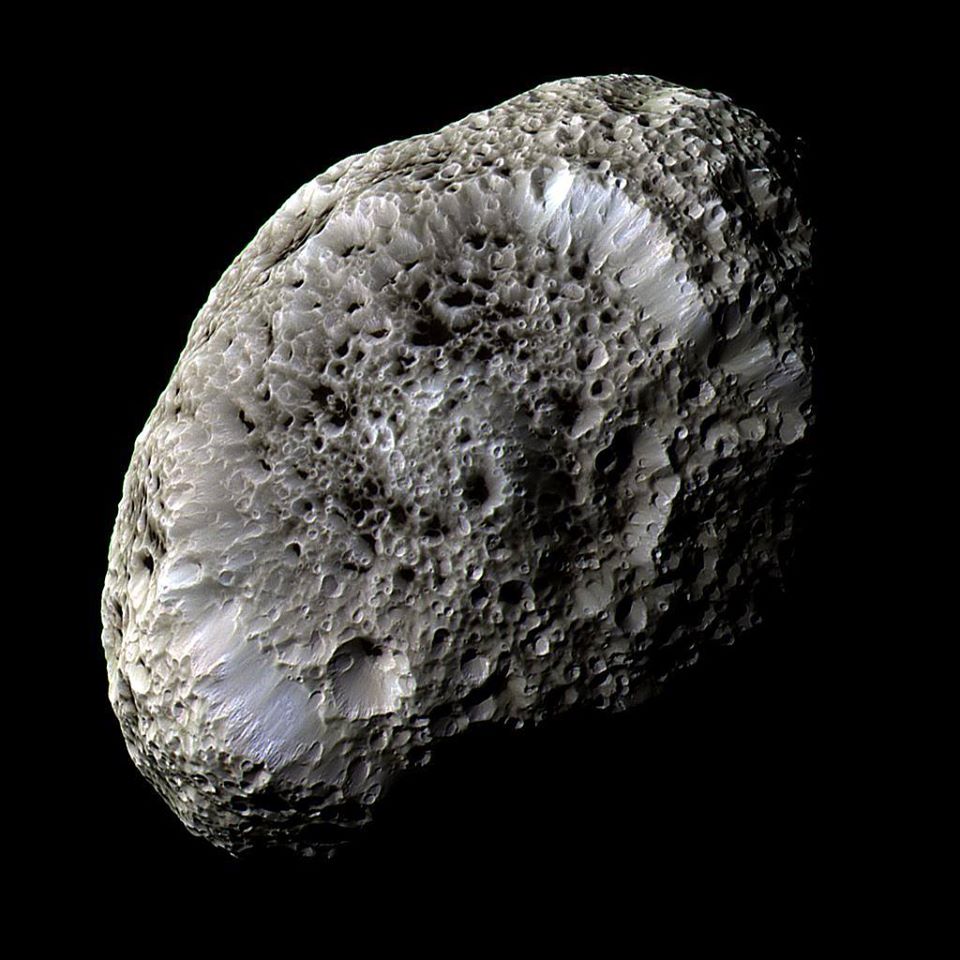
5.8 Iapetus:
Iapetus, third largest moon of Saturn, is 736 km in diameter. Below we use two photos, because Iapetus is a two-tone black-and-white, yin-and-yang piece of uniqueness. Early measurements in the year 1671 revealed the differing brightness of the two hemispheres of Iapetus - and if you’re old enough you might remember the ‘eye of Japetus’ from the book and movie ‘2001:A Space Odyssey’. The photos are from the encounter of the Cassini spacecraft (named after the discoverer of Iapetus) in 2007. Iapetus is tidally locked with Saturn, and it is the leading side that has the dark coating, the rest of the moon displaying the underlying ice. The current theory is that the ‘dark hemisphere’ consists of dark material from some other body (maybe the moon Phoebe). But there is a problem - there aren’t many craters on the dark side, so it either got dark quite recently, or it is continuously being ‘repainted’ by dark stuff. Iapetus orbits 15.5 degrees out of the plane of Saturn's rings, so it’s the only moon of Saturn from which you could see the rings properly. Its ‘day’ is 79 Earth days, so it would be a good project with your backyard telescope to try and repeat Cassini’s observation of it being dark on one side of Saturn (mag 12) and light on the other (mag 10).
Observations using the Cassini probe showed that the dark stuff is kind of entrenching itself - it preferentially absorbs sunlight, and the little bit of extra warmth causes some of the underlying ice to sublimate and eventually condense on the light side. There is also a ridge around the circumference that makes it look like a cheap squash ball, two hemispheres poorly joined together.
Figure 5.8. Iapetus (below)
Image Credit: NASA
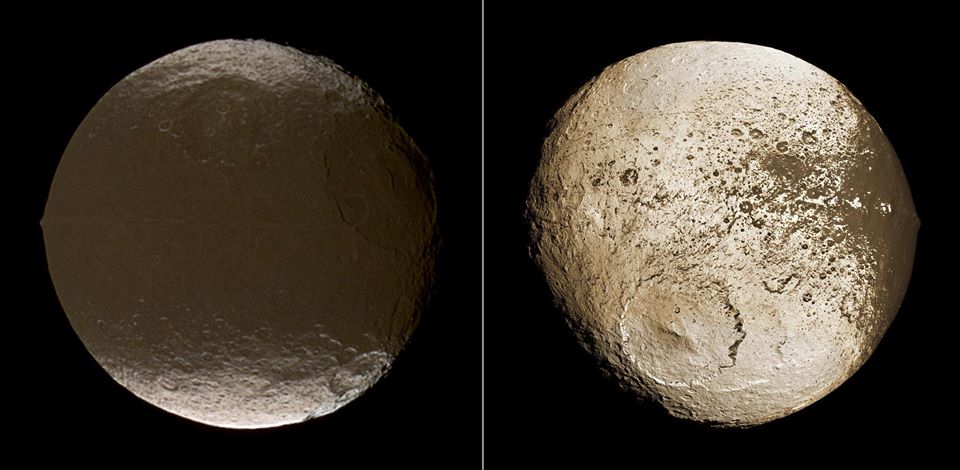
5.9 Phoebe
Phoebe, a distant moon of Saturn, orbits more that 12 million km from the Planet - more than 30 times the distance from Earth to our Moon.
Phoebe is only about 200 km across, less than 1/10th the size of our Moon. It has a very notable orbit - as well as being a long way out, it is retrograde, meaning that it orbits in the opposite direction to the way the Saturn spins. It also spins the 'wrong way' - its north pole is opposite to Saturn's. It’s also quite some way out off the equatorial plane, and has a dark surface - all these points being evidence that it’s been captured by Saturn as it was passing through. In fact, it could be one of the oldest bodies in the Solar System, quite possibly a survivor of the original formation of the planets from a disk of dust and gas accreting round the Sun.
There is a theory that black dust from Phoebe, ejected by collisions that formed its many craters, could be the source of the dark stuff painting the leading edge of Iapetus, and evenly covering Hyperion.
Figure 5.9. Phoebe (below)
Image Credit: The photo is from the Cassini flyby in 2004.
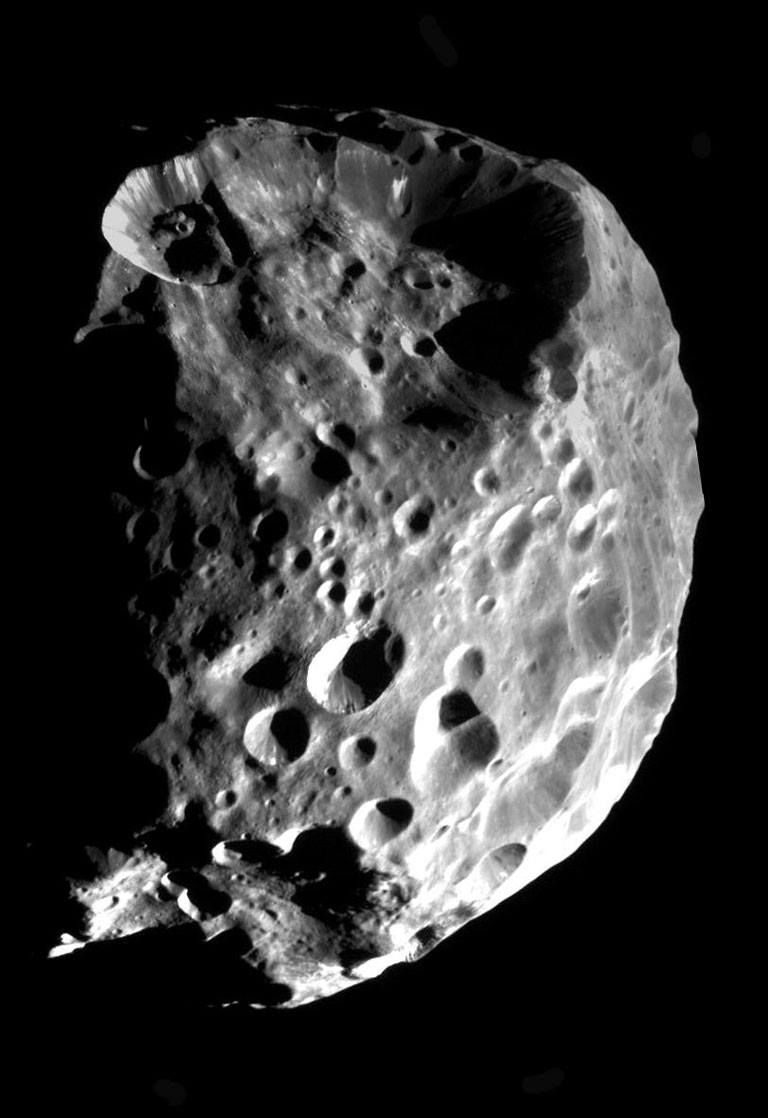
5.10 Epimetheus and Janus
Orbit Swap! Epimetheus and Janus are two moons of Saturn with a very special relationship. In certain circumstances, moons can give each other a 'gravity assist', causing one to accelerate and the other to decelerate. Here is an example where we reach the logical conclusion: two moons in close orbits, that swap places when they pass each other every four Earth-years.
Epimetheus is a beaten-up piece of rock about 100 km across and billions of years old. Janus is similar but larger, about 180 km across. The two moons travel in orbits that differ in the average distance from Saturn by only about 50 km. The moon on the inner orbit creeps up on the outer one and, as they approach, their mutual gravitational pull causes them to swing around and switch places! The moon newly in the lower orbit then creeps off ahead and they repeat the feat next time they pass. If you plot their orbits in a rotating frame of reference you’ll find they are in horseshoe orbits - like the asteroids and things that orbit around between the Lagrange points.
Figure 5.10. Below: Epimetheus is on the left, Janus on the right.
Image Credit: NASA/Cassini

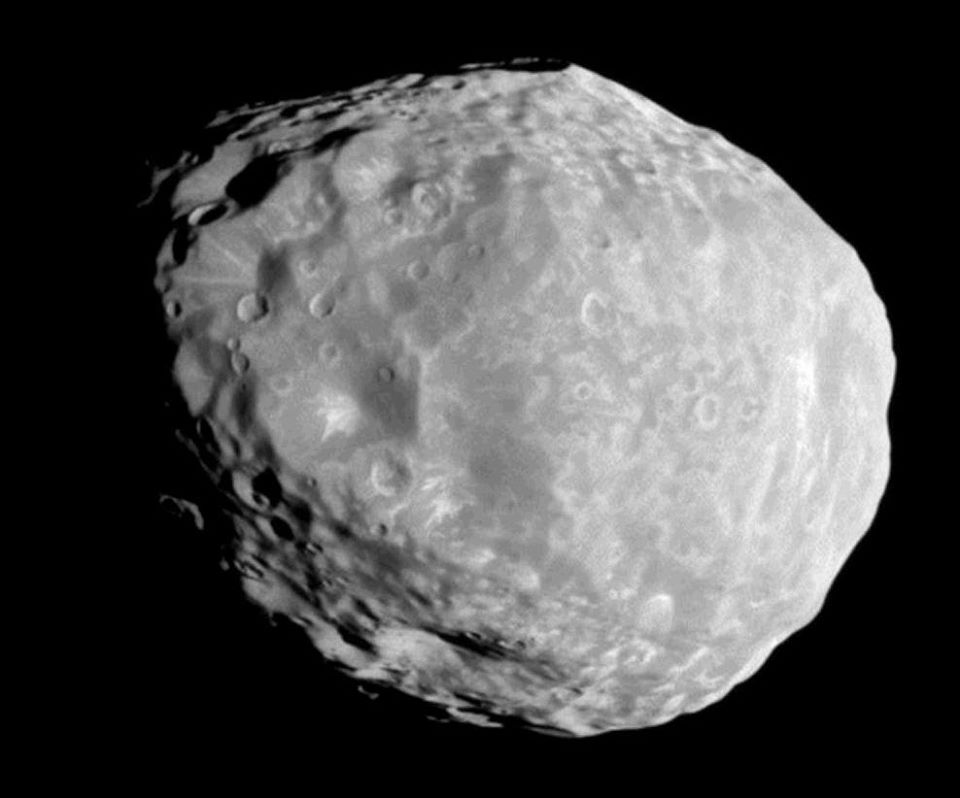
There is also a video of their orbits here.
5.11 Pan:
Poor old Pan! What happened to It? One of the moons of Saturn - it looks like, instead of growing up to be a proper, spherical moon, it's trying to look like a "Mini-Me" of Saturn - a sphere with a funny planar layer around the middle, emulating Saturn’s rings. Hmm, maybe that's a clue as to how it got its strange shape?
It’s about the 19th most-massive moon of Saturn, and the spherical-ish bit is about 28 km in diameter - about the same size as Singapore! Based on its reflectivity, it is probably about 50/50 ice and rock, like most of the outer moons in the Solar System. Because Saturn is so massive, Pan whips around in its orbit in under 14 hours!
Now if you know anything about Saturn, you know that it has rings! Not a single ring, but multiple rings, which are separated by narrow empty gaps. Well, Pan orbits within the rings - and where it orbits it has created a small gap called the "Encke Gap" near the outer edge of Saturn’s rings. With regard to 'gravity assist', there is an analogy - "If trucks had large gravitational pulls, they would slow you down when you overtake them, and speed you up when they overtake you". So now think about a 28 km lump of rock orbiting inside Saturn's rings. The ring particles closer into Saturn get slowed down as they overtake Pan, while the slower particles further out get speeded up a little as Pan overtakes them. The result is that the moon pulls ring particles into its own orbit and, within a few orbits, collides with them. At this point they stick to Pan! As it's small, it doesn't have enough gravity to pull itself into a spherical shape and, instead, it grows a ridge around its equator. Poor old Pan! This simple theory based just on gravity explains why Pan orbits in a gap and has its odd shape. There are some other moons that do the same thing within Saturn's rings, and they are called 'Shepherd moons' because, supposedly, they keep the small ring particles corralled into their allotted bands. By the way, those of you who noticed the odd equatorial ridge on Iapetus now have a clue as to where that came from! The two images below, from different directions, were made from data from the Cassini probe in 2017.
Figure 5.11. Pan (below)
Image Credit: NASA

5.12 Atlas
Atlas, the other 'flying saucer'! Atlas is, like Pan, a moon of Saturn that orbits at the outer edge of the main ring system (the 'A' ring). Whereas Pan orbits inside the ring, Atlas is outside it. Ah, so how did it get its equatorial ridge then? It turns out there is actually a faint 'ring' of fine dusty material extending out beyond the A ring, and this is the material that has accreted onto Atlas. If you compare it with the image of Pan, you’ll notice that Atlas has a much smoother surface and no sharp corners or features. This is evidence that it's been gathering dust (actually small particles of mostly water ice). Atlas is smaller than Pan, 15 km, orbits a bit further out (138,000 km) and has a fast orbit (14.4 hours per orbit). Due to the influence of two other moons, Prometheus and Pandora, it oscillates up and down out of the plane of the rings by up to 600 km. But the oscillation is slow, with a period of about three years.
Figure 5.12. Atlas (below)
Image Credit: The photo is from the Cassini probe’s visit in 2017.

5.13 Propeller Moons!
The rings of Saturn are mostly made of small ice particles. But in among them float some small moons - less than one kilmetre across and mostly around 100 metres across. They were too small to see using the Cassini probe - but we know they are there because we can see the 'bow wave' and 'wake' that they make within the ring particles. If you look at these 'propeller structures' you can see that the leading blade of the propeller (at right) is on the Saturn-ward side of the moon, and the trailing one (at left) is on the outboard side of the moon. In these areas the ring particles bunch up and reflect more light than the average.
Figure 5.13. Propeller Moons (below)
Image Credit: NASA/Cassini
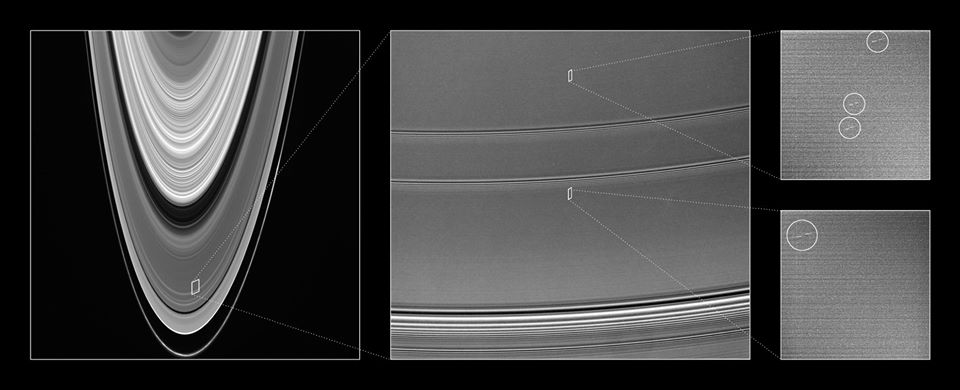
6.1 Titania
Titania is the largest moon of Uranus, and the one that orbits fourth out of the five large moons. It's about 1500 km in diameter, which is about half the diameter of Earth's Moon. As with the other major moons of Uranus, it spends 42 years with the south pole facing the Sun, then 42 years with the north pole facing. Titania is about 50/50 ice and rock (like most other moons in the outer Solar System); it has a slightly reddish colour and has one hemisphere slightly darker than the other. It's thought that the darkening is caused by ions from Uranus's magnetic field liberating hydrocarbons, the same mechanism that makes Umbriel dark (refer 6.3), but in this case, only on one hemisphere. If you recall two-tone Iapetus, it was darker on the 'leading' hemisphere as it got partly coated by something from space. Well, the surprise with Titania is that it is darker on the TRAILING side! This is because the darkening is not the accretion of dark stuff from outer space, but the action of Uranus' magnetic field. It so happens that, for Titania, ions from the magnetic field preferentially impact on the trailing site. The lesson from this - every moon is unique and has its own environment and history.
Titania has some other interesting features. As you can see in the photo below (from Voyager 2, the only spacecraft to visit Uranus), is has some giant scarps, some of which trail across the surface in pairs to form canyons. How did these form? Well, it's most likely that they formed when the outer layers of Titania expanded. Say what? The story goes like this: the idea is that it was, at some point, heated enough (perhaps by a collision) that the rock sank to the middle, forming a rocky core with an icy mantle. This idea is supported by the evidence of a lot less cratering than the moon Oberon, showing that is has a younger surface. The core and mantle would have then frozen from the outside in, creating a hard icy shell, then heating of the newly-concentrated core by natural radioactivity later warmed the moon and made the surface expand. The result: wrinkles.
Figure 6.1. Titania (below)
Image Credit: NASA/Voyager 2
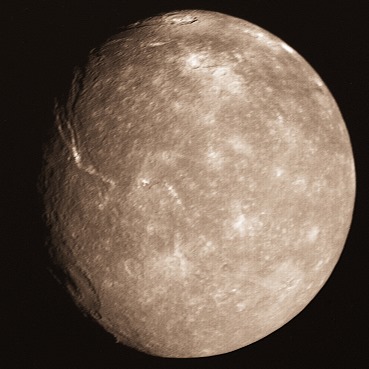
6.2 Ariel
"Hang on, we've already seen that one! (part 2)". Oh no, you haven't. That was Titania, this one's Ariel, another moon of Uranus. At 1158 km diameter it's a bit smaller than Titania, and it orbits a lot closer in to Uranus - at about 190,000 km where the gradient of Uranus' gravity field is steeper, so it gets some tidal heating as it travels in its slightly elliptical orbit. It does look similar to Titania - it has a similar composition, about half and half rock and water ice and, in addition to its craters, it has large rift valleys (grabens) suggesting that it too had a heating period in its history that made the whole moon expand.
Ariel actually has the brightest surface of any of Uranus' moons - a relative term because, even so, it reflects less than 30% of the light falling on it. It also gets significantly brighter when it's 'in line' with Uranus and is reflecting light directly back towards the Sun (and us). This suggests it has a porous surface which normally looks dark as the roughness casts lots of shadows.
Figure 6.2.a. Ariel (below)
Image Credit: NASA/Voyager 2

Figure 6.2.b. Ariel surface detail (below)
Image Credit: NASA/Voyager 2
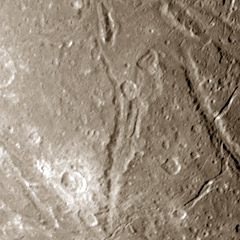
6.3 Umbriel
Umbriel is the third-largest moon of Uranus - but the fourth in terms of mass. Its orbit averages 266,000 km radius, and its orbital period is a bit over four Earth days, the same as its rotational period. Umbriel is the darkest of the five major moons of Uranus, and crater counting shows that it has the oldest surface of the five – i.e. that it is a 'boring' object without many processes going on that can regenerate the surface. Like most of the outer planet moons, it's thought to be about 50/50 rock and water ice, though Umbriel might be slightly higher in water ice than is usual. Because of its highly inclined orbit, its north pole spends about 42 years facing the Sun, after which the south pole gets its time in the Sun, while the north pole spends 42 years in total darkness. The relative darkness of the surface of Umbriel might be something to do with ions energised by Uranus' magnetic field liberating hydrocarbons (mostly methane) from the ice which can then combine into heavier hydrocarbons raining down onto the surface. But we won't really know until someone or something gets up close to analyse the surface. The second photo is my own picture of the major moons of Uranus, from November 2019.
Figure 6.3.a. Umbriel (below): The photo below is from Voyager 2 in 1986 - when the south pole was in daylight - and shows a startling bright ring around a crater which has been named "Wunda". The ring may be due to ice reforming in the floor of the crater, presumably after partial melting, but we don’t really know.
Image Credit: NASA/Voyager 2
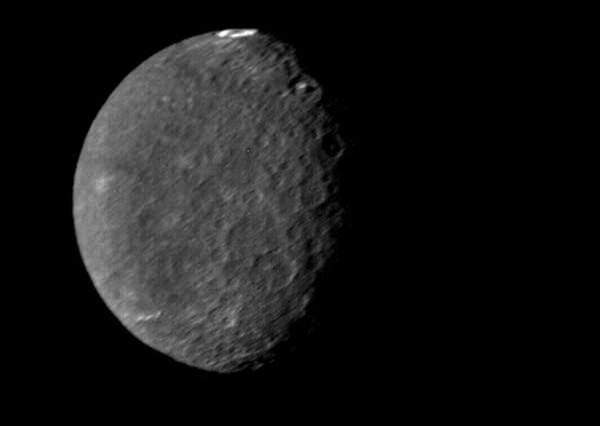
Figure 6.3.b. Uranus and its brightest moons
Image Credit: Ian Kemp
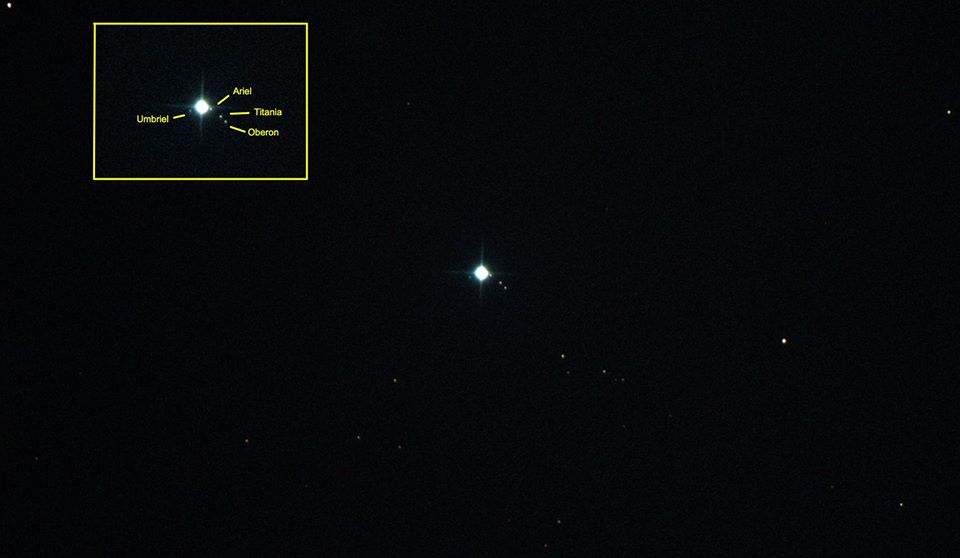
6.4 Miranda
This is the 5th largest moon of Uranus. The planet's poles lie nearly in the plane of the Solar System, and the moons orbit out of the plane of the Solar System. When this mosaic image was made using data from Voyager, Miranda's south pole was pointing toward the Sun. The large patches called 'coronae' are likely to have formed when the icy surface melted and re-froze following meteorite strikes.
Figure 6.4. Miranda
Image Credit: NASA/Voyager 2
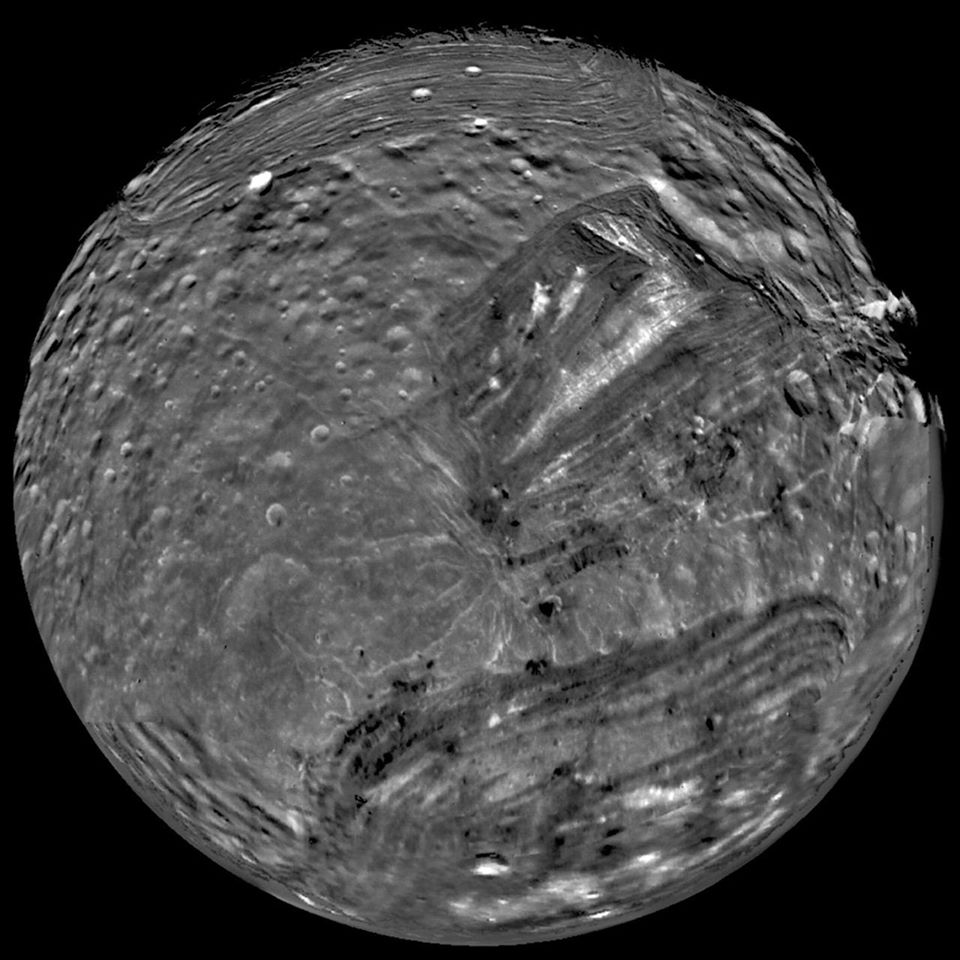
7.1 Triton
Triton is the moon that has it all. Triton is the largest moon of the outermost planet, Neptune. It’s thought to be a captured Kuiper Belt Object (KBO) and it has a lot of similarities to the Dwarf Planet Pluto. But is has a lot going on that makes it special in several ways. Firstly, at 2700 km diameter, it is larger than Pluto. So, if it were still hooning around in the Kuiper Belt, it would be the largest known KBO. It is the only major moon in the Solar System that has a retrograde orbit - meaning that it orbits Neptune the ‘wrong way’ - in the opposite direction to the orbits of all the planets and the other major moons (some small moons have retrograde orbits). Also, the plane of its orbit is so high that at moments during each orbit its poles point towards the Sun. The unusual orbit is the best evidence that it’s a captured object, rather than having been formed along with the planets.
Next, it has an unusually high density, in fact one of the highest of the moons of the outer Solar System, showing that it has a large percentage of rock and relative less ice. Furthermore, it has a crust of solid nitrogen and methane sitting over its rocky core and ice mantle. Solar heating causes some of the nitrogen to erupt from geysers, forming a thin nitrogen atmosphere - and it’s the sublimation and re-freezing of nitrogen that gives the major part of the surface its dimpled appearance. The low crater population shows that it has an active surface - and the Voyager 2 space probe spotted ‘lava lakes’ which are a sure sign of volcanoes on the moon! These are not the same as Earth volcanoes though, they’re cryovolcanoes which erupt water through the nitrogen crust, and form lava lakes of frozen water ice. Voyager 2 is the only spacecraft to have visited Neptune, and the evidence of nitrogen geysers, cryovolcanoes, and the images below (Triton and a crater on a 'lava' lake) all came from Voyager 2.
Figure 7.1.a. Triton
Image Credit: NASA/Voyager 2
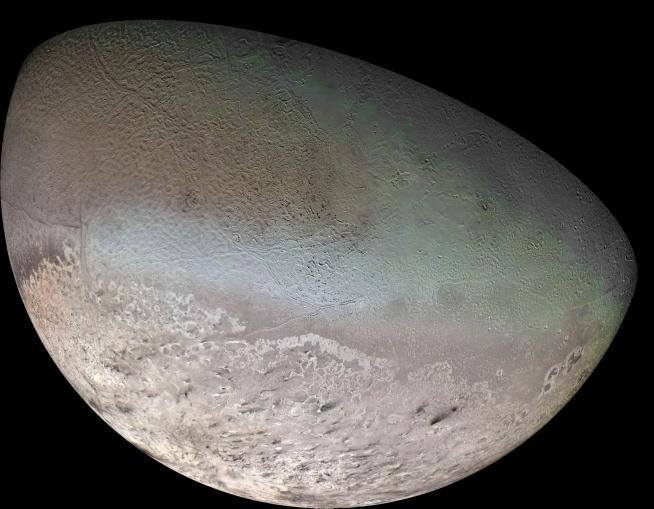
Figure 7.1.b. A crater on an ice lake on Triton
Image Credit: NASA/Voyager 2

8.1 Charon
Charon (various pronunciations are in common use) is the largest of the five moons of the dwarf planet, Pluto. Charon is only 1200 km across, but it has the distinction of being the largest moon in the Solar System, relative to its parent. It's just over half the diameter of Pluto, and 12% of the mass. It is so large that Charon and Pluto orbit a common centre of mass in space, outside the surface of Pluto. The nearly circular orbit is suggestive that Pluto and Charon formed at the same time, possibly by a massive impact that split apart an earlier parent body.
Charon is mostly made of water ice, and it may have a rocky core. Its surface is lacking the methane which covers much of Pluto's surface, and it has some dark material deposited around the north pole, which is believed to be a mixture of hydrocarbons and CO2 ejected from Pluto, chemically modified by UV from sunlight, and by cosmic rays. The moon has a massive canyon over 1100 km long, and up to 9km deep, which may or may not have formed in an impact event. Also, the southern hemisphere has noticeably fewer craters than the north, suggesting that it has been resurfaced at some point. One hypothesis is that the impact event which created the canyon liquified water in the southern part of the moon, and eruption of cryovolcanoes flooded the southern surface with water ice which promptly froze. If you have a better idea please let me know!
Figure 8.1.a. Charon
Image Credit: NASA/New Horizons
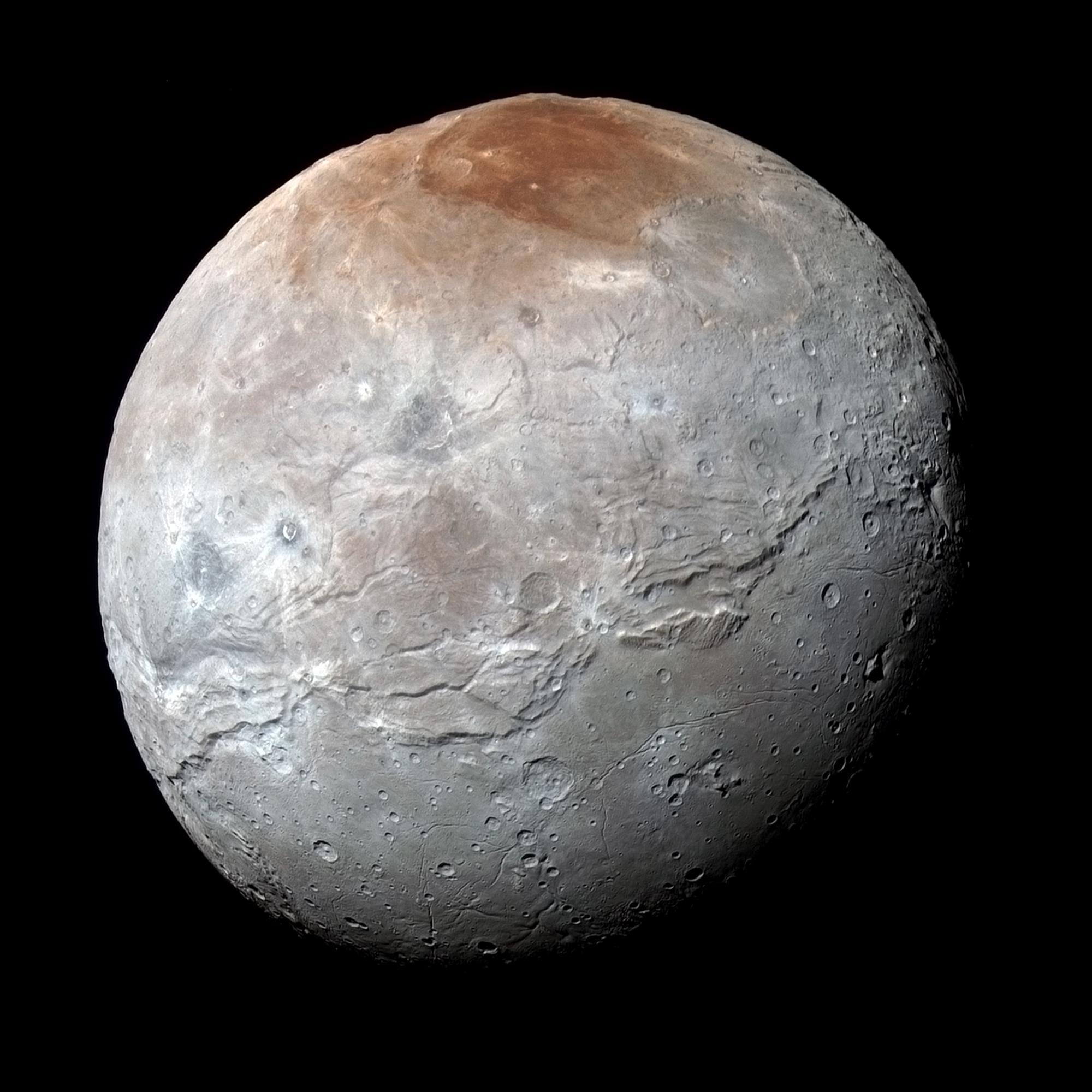
Figure 8.1.b. Charon and Pluto
Image Credit: Source

9.1 Dysnomia
Dysnomia is a troublemaker or a game-changer, depending on your point of view. First, let’s meet Eris. Eris is a Kuiper Belt Object (KBO) which was discovered in 2003. At the time of discovery, its distance from the Sun was three times that of Pluto. We now know that its orbit is very eccentric, and at closest approach it is about the same distance out as Pluto and its year lasts 580 Earth years. Two years later, astronomers using the Keck observatory in Hawaii discovered that Eris has a moon! This object was eventually named Dysnomia, and studies of the mutual orbit allowed an estimate of Eris’ mass. It was the discovery that Eris was both larger and more massive than Pluto that led to the creation of a new classification of Solar System object: Eris became the first ‘Dwarf Planet’, and Pluto was re-classified from a Planet to a Dwarf Planet. This bit of Taxonomical Tidiness seems to have upset some people who still like to rant on the subject on the Internet. Anyway, little is known about Dysnomia because no space probe has yet been near it. It was found later that Eris is, in fact, smaller than Pluto, but has a larger mass. All studies (imaging and spectral) have been done from Earth. One of the other Dwarf-Planet-Moons has been shown to be almost pure water ice, so our best guess is that Dysnomia is the same. Pure theory, but it is thought to have formed from a collision between Eris and another KBO. The image of Eris and Dysnomia is from NASA and ESA, taken using the Hubble Space Telescope.
Figure 9.1. Dysnomia
Image Credit: The below image of Eris and Dysnomia is from NASA and ESA, taken using the Hubble Space Telescope.

9.2 G!ò'é !Hú
G!ò'é !Hú, the moon of the TNO 229762 Gǃkúnǁʼhòmdímà: The primary was discovered using an Earth-based telescope in 2007, by a team which included Michael Brown, the astronomer whose discovery of Eris led to all the ructions relating to Pluto's taxonomic status. This object is a good example of a typical midsize member of the Kuiper Belt; it's about 650 km in diameter, has a low density and is not spherical; it has an eccentric orbit around the Sun and a quite high inclination of 23 degrees out of the average for the Solar System. Its year is about 620 Earth years, and its day is somewhere between 11 and 49 hours. When discovered it was about 64x times the distance of Earth from the Sun. It also has a very cool name which is quite difficult for English speakers to pronounce, but is the name of a spirit girl in one of the languages of the !Kung people of Namibia. Apparently, the spirit girl sometimes appears as an aardvark, and her job is to punish wrongdoers using an Oryx Horn.
The 100 km sized moon G!ò'é !Hú is named for the Oryx Horn! It orbits its parent about 6000 km out, with an orbital period of just over 11 days. It was discovered in 2008 using the Hubble Space Telescope, which provided the image below. This moon is actually quite interesting in that it is one of the reddest known TNOs - implying that its icy body has been coated with something. Also, observations of occultation (when the object passes in front of a star) have shown that the moon's orbit is very nearly circular, which suggests that it may have formed at the same time as its parent, rather than being a capture. By the way, the correct way to pronounce the name of the primary and its moon are given here and here, respectively. As a final note, there are a lot of largeish TNOs with Moons. Not all can be covered here.
Figure 9.2. G!ò'é !Hú
Image Credit: Hubble Space Telescope/STScI
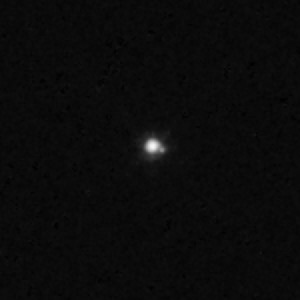
We have covered the point that every moon is unique! Moons can orbit planets, dwarf planets, asteroids, other moons and even empty space (Lagrange points). I’ve mentioned gravity assist, propeller moons and orbit swaps. We’ve seen that Moons can be made of any combination of iron, rock, water ice, and hydrocarbons, and have even seen a landing on the hydrocarbon-dominated Titan. We have seen basaltic lava lakes, sulphur deposits, cryovolcanoes, and geysers squirting water into space; and we’ve seen at least three moons that have liquid water oceans under their surfaces. I hope you agree that Earth has two moons and recently had three! For series on other subjects of interest, join the Closed ASNSW Facebook Group here. You do not need to be a member of the ASNSW to join this Facebook group.
Author: Dr Ian Kemp (ICRAR), from content posted to the ASNSW Facebook Group, various dates in 2020. Last updated 18 July 2020.

